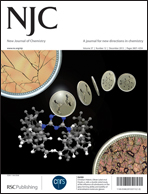Highly sensitive detection of Hg2+ in aqueous solution using cationic polythiophene derivatives†
Abstract
Two novel water-soluble conjugated polymers poly{3-[1-(2-trimethylammoniumacetyl)piperidine-4-methylene]thiophene-2,5-diyl chloride} (PTAPT-Cl) and poly{3-[1-(2-trimethylammoniumbutyryl)piperidine-4-methylene] thiophene-2,5-diyl chloride} (PTBPT-Cl) have been synthesized via chemical oxidative polymerization and applied as a colorimetric and fluorometric probe for the detection of metal ions. Moreover, the fluorescence detection of metal ions using previously synthesized poly[N,N,N-trimethyl-4-(thiophen-3-ylmethylene)cyclohexanaminium chloride] (PTCA-Cl) and poly[3-(1,1′-dimethyl-4-piperidinemethylene)thiophene-2,5-diyl chloride] (PDPMT-Cl) was also investigated and discussed. All four conjugated polymers exhibited high sensitivity and selectivity to Hg2+ with a fluorescence “turn-off” mode at pH 3 in aqueous solutions. The best detection limit was as low as 10−9 M without interference from other common metal ions. Consequently, the distinctive quenching of the emission bands in the presence of various metal ions can lead to qualitative and quantitative Hg2+ detection in aqueous solution by a new approach using cationic polythiophene derivatives.


 Please wait while we load your content...
Please wait while we load your content...